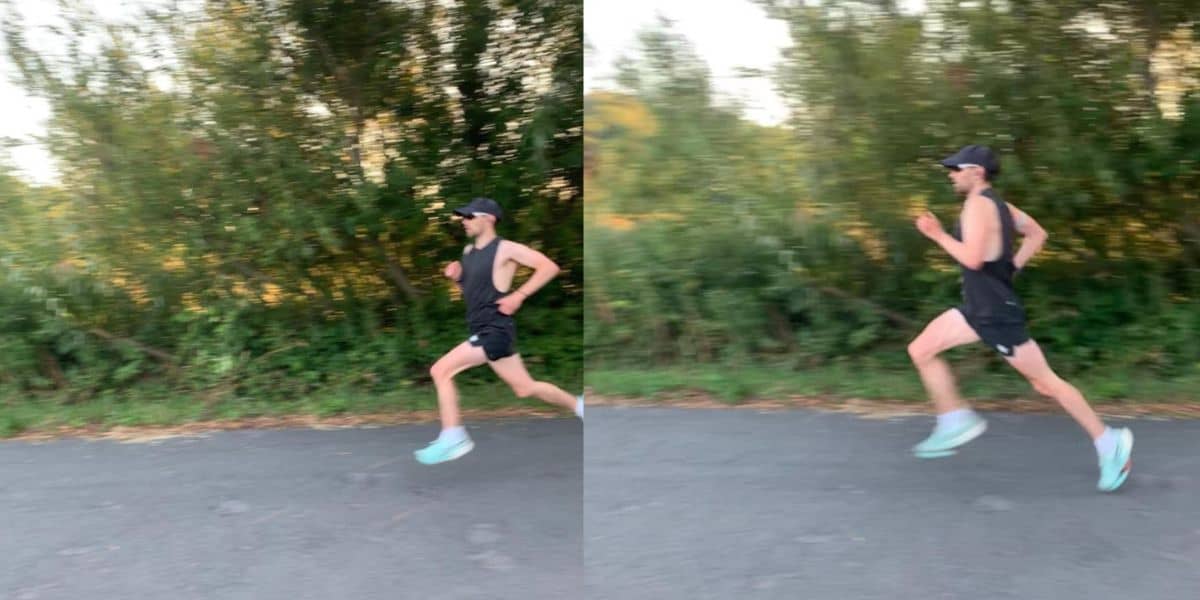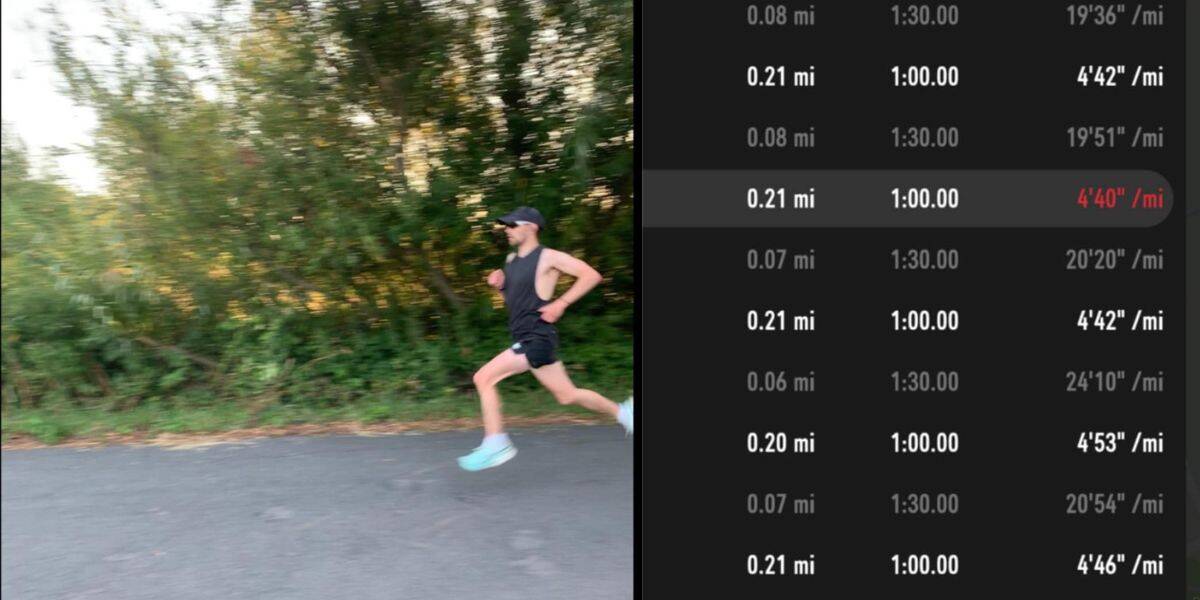My first 5K was 16:20. Not terrible, but nothing special. Five years later, I crossed the line in 15:09.
That journey cost me months of mistakes, breakthrough moments that changed everything, and insights you won't find in typical training articles.
As a UESCA certified running coach who's guided other runners to PRs, I've learned that the advice that sounds impressive often isn't what works. Here's what actually drops time off your 5K.
The Breakthrough That Changed Everything

For three years, I was stuck. I'd broken 16 minutes in year two, then spent the next three years chasing marginal gains while making one critical mistake: I thought harder was always better.
The breakthrough came from a workout I initially thought was "not tough enough" - 20 x 400m in 70 seconds with just 45-60 seconds recovery.
But here's what made it work: I felt controlled throughout. Like I could go faster if needed, but the intensity was just right.
That workout taught me the most important lesson of my running career: the best training stimulus often feels easier than you expect.
Why Your Track Sessions Are Probably Too Hard
The biggest mistake I see recreational runners make? Crushing themselves in track sessions while ignoring the moderate stuff that actually builds fitness.
I spent months running mile repeats at 4:35-4:40 pace when my 5K goal was 4:52 per mile. Sounds logical, right? Wrong. I was teaching my body to blow up, not how to sustain speed.
Here's what works: Most of your speed work should feel controlled. On tempo runs for example you should feel like you could pick up the pace or carry on if you had to. That's the whole point.
The runners crushing 4:40 mile repeats for a 5K goal are treating every workout like a time trial. Meanwhile, the ones improving are hitting their paces consistently and finishing workouts thinking "I could have done more."
The Training Week That Got Me to 15:09

When people see my peak training week, they're usually surprised by two things: the volume and the double days. Here's what a typical week looked like:
Monday:
Strength training (weights), complete rest from running
Tuesday:
AM: 6 x 6 minutes at HR 155 (threshold)
PM: 15 x 1 minute around 5:00 mile pace
Wednesday:
Easy 8 miles,
Optional PM 4 miles
Thursday:
AM: 4 x 6 minutes at HR 155 with 1 minute rest
PM: 5 x 1 mile at HR 170 (threshold-based)
Friday: Easy 8-10 miles
Saturday: 6 x 1K in low 3:00s with 90 seconds recovery
Sunday: Long run 15-18 miles
The double days are not about being impressive - they are about getting more quality without destroying myself. Two focused 20-minute sessions hit different energy systems better than one exhausting 45-minute grind. Plus, they fit around a working day.
The Pacing Strategy That Wins Races
Here's where I'll lose some coaches: I don't run even splits in 5Ks.
My 15:09 was split roughly 2:58, 3:02, 3:02, 3:02, with everything left in the final kilometer.
Most people would call that positive splitting, but here's why it worksfor me:
Going out in 2:58 gets me in the right group - runners targeting similar times or slightly faster. When I settle into 3:02s, the pace feels manageable because I'm hanging on rather than leading.
It's like getting free time, but there's a fine line - go 15 seconds faster than goal pace and you'll likely blow up.
The key is that first kilometer. It shouldn't feel easy, but it shouldn't feel unsustainable. You're buying position and rhythm, not trying to bank time.
What Sub-15:30 Runners Actually Do
The difference between 17:00 and sub-15:30 isn't just fitness - it's understanding effort distribution.
17:00 runners think: "I need to run every workout as hard as possible."
Sub-15:30 runners know: "I need to run most workouts at the right intensity, not maximum intensity."
The fastest runners I know still do recovery runs at 7:30-8:00 pace sometimes. They understand that easy days enable hard days, and hard days should feel controlled, not desperate.
The Volume Truth Nobody Wants to Hear
My most controversial opinion? Most runners can handle more mileage than they think, and volume matters more than fancy workouts for 5K improvement.
I'm not saying jump from 30 to 70 miles per week overnight.
But if you can safely increase your weekly mileage, that's often the missing piece.
Endurance matters in the 5K more than people realize - it's what lets you maintain form and pace when others fade.
The runners asking about the perfect interval session are often running 25 miles per week. The ones consistently hitting PRs are logging 50+ miles with boring, sustainable training.
The Gear That Actually Matters

Asics Metaspeed Edge Paris
Carbon-plated shoes have made a real difference in the last five years, both in training and racing.
My Asics Metaspeed Edge Paris helped me maintain competitive times through better energy return and efficiency.
I also ran a 15.37 5k in Puma's recently launched updated super shoe the Fast-R Nitro Elite 3s
But here's what doesn't matter as much as marketing suggests: most other gear. Moisture-wicking shirts are nice, GPS watches are helpful for pacing, but they won't drop 30 seconds off your time.
Race Day: What Happens in the Final 400m
The difference between a 15:09 and 16:00 runner in those final meters? Mainly fitness, but there's a mental component too.
At local races, I'm often thinking about winning, not just time.
That competitive element - focusing on beating the runners around you rather than just surviving - can unlock surprising speed. It's the difference between running scared and running aggressive.
Recovery Techniques

Using a foam roller on Hamstrings
Recovery is a crucial part of any right training program. Incorporating proper recovery techniques ensures that your body heals and adapts, allowing you to train harder and perform better.
Sleep
Adequate sleep is essential for your body’s repair and recovery processes following training stress. Good sleep habits can significantly enhance your performance by aiding muscle recovery and reducing fatigue. I personally aim to get 8 hours of sleep a night.
After a race, remember to take it slow, allowing your body enough time to recover through rest and sleep for two weeks before the next race.
Mobility Work
Mobility work aims to enhance joint movement, reducing stiffness and potentially preventing injuries. Regular practice of mobility exercises can lead to noticeable improvements in flexibility and performance within weeks.
Targeting key areas like hips, ankles, quadriceps and hamstrings during mobility work helps reduce the risk of common running injuries.
Sports Massages
Regular sports massages can significantly reduce muscle soreness and accelerate the recovery process.
These massages help identify muscle tension and can contribute to faster recovery after intense workouts.
Incorporating sports massages into your routine maintains muscle health and optimizes performance.
Training Progression That Actually Works
If you take one thing from this article, make it this: progression happens in phases, not workouts.
Your breakthrough won't come from one heroic session. It'll come from stringing together months of consistent, appropriately challenging training where most workouts feel controlled and sustainable.
What I'd Tell My 16:20 Self
Stop trying to prove how tough you are in every workout. Start treating training like a long-term investment, not a daily test of willpower.
Focus on volume before intensity. Master the boring stuff - easy runs, tempo runs, consistent mileage - before chasing exotic intervals.
Most importantly: the training that breaks you down isn't the training that builds you up.
Your Next Steps

If you're currently running 17:00-18:00 for 5K, focus on building your weekly mileage safely and mastering tempo runs. The track can wait.
If you're in the 16:00-16:30 range, start incorporating controlled speed work while maintaining that easy day discipline. Your easy runs should still make up 80% of your training.
If you're chasing sub-15:30, it's about consistency and patience. The fitness is built over months and years, not weeks.
The journey from 16:20 to 15:09 taught me that getting faster isn't about suffering more - it's about training smarter, more consistently, and with better understanding of what actually creates adaptation.
Now go run that breakthrough workout. Just remember: if it feels like you're dying, you're probably doing it wrong.
Frequently Asked Questions
What is the importance of easy runs in my training plan?
Easy runs are essential because they build endurance and aid recovery, constituting around 80% of your training. As I learned in my own development from recreational runner to sub-15:10, prioritizing these runs can really enhance your overall performance.
How can I determine my goal pace for a 5K race?
To determine your goal pace for a 5K, assess your current performance honestly and consider using a GPS watch to track your pace and distance effectively.
What should I eat before a 5K race?
Eating a carb-rich meal before your 5K is key, so stick to pasta, rice, or a banana and avoid too much protein, fat, and fiber to keep your stomach happy. I typically have a light breakfast 2-3 hours before racing.
